 How can rare book sellers determine the optimal price for their items brought to market? If the price is set too high, the buyers may not bid to buy, if the price is set too low, the stock may be sold below optimal pricing. The information that is needed to set the right price for any rare book is typically distributed among the many sellers and buyers who, for the most part, maintain such information private. Only the seller dealers know how much profit they are willing to sacrifice by offering a discount to potential buyers. Only prospective buyers know how much they are willing to pay for items they are collecting. It is thus quite obvious that market prices are not, by themselves, sufficient to guide sellers on optimal pricing.
How can rare book sellers determine the optimal price for their items brought to market? If the price is set too high, the buyers may not bid to buy, if the price is set too low, the stock may be sold below optimal pricing. The information that is needed to set the right price for any rare book is typically distributed among the many sellers and buyers who, for the most part, maintain such information private. Only the seller dealers know how much profit they are willing to sacrifice by offering a discount to potential buyers. Only prospective buyers know how much they are willing to pay for items they are collecting. It is thus quite obvious that market prices are not, by themselves, sufficient to guide sellers on optimal pricing.
Marketplaces in which prices alone can guide efficient trade of rare books are highly theoretical. Adam Smith first described the concept of the invisible hand, which guides markets and renders external interference unnecessary, in his 1776 classic, The Wealth of Nations. But how buyers or sellers come to agree on a price that is mutually satisfactory is far more complicated than Adam Smith’s famous concept. Buyers want to pay as little as possible, while sellers seek to sell books at the highest possible price. In economics theory, competitive equilibrium is attained when the price, for the quantity available for sale is equal to the price for the quantity demanded. Note that the competitive equilibrium price is not necessarily the same as the optimal price, at which the total profit of the seller is maximized.
Rare books are heterogeneous, for the most part. Each book has unique attributes which vary from one to the next, such as; condition, imprint, provenance, autographs, marginalia, etc. As a result, sellers have the flexibility to inflate pricing for items that are perceived to be collectible. While this practice discourages bargain hunters, it can lead to overestimating the market’s inelasticity of demand. Despite the uniqueness inherent in rare books, there also exists a certain level of substitution. Two books are near-substitutes if an increase in the price of one book increases the demand for the other. All rare books can generally be considered to have near substitutes, with some variation in genre, authorship, imprint, physical properties, etc. The extent to which a price change in one, affects the demand for another, is dependent on how close they come to being perfect substitutes.
The figure below depicts a hypothetical world, in which 3 competitive equilibriums for two sets of near-substitutes A and B are attainable. The area below the curve for Rare Books A is occupied by the excess demand for its near-substitute – Rare Books B, while the area above the curve is occupied by the excess supply for its near-substitute. As prices for the limited quantities of A & B rise, the curves converge, first at area 1, which is the lowest market-clearing price, where there will be zero excess demand and where prices stop increasing, at least temporarily. If prices start high with scarcer quantities, prices converge monotonically down to the highest market-clearing, at area 3. At these points, where the curves cross, a pair of prices and quantities with neither excess supply nor excess demand for either A or B, is where competitive price equilibrium is reached.
Even though the mathematical proof to the theory is well-formulated, the practical problem to finding optimal prices can still be daunting. With near substitutes, the best way to find optimal prices aside from trial and error, is through an auction of some kind: on-line, live, reverse, bid-ask negotiations, etc. With auctions in mind, the substitute aspect generates prices that are good guides to pricing decision making. In theory, the equilibrium price attained at the highest market-clearing area, is the optimal price for sellers to price their similar items. It implies that auctions which start the bidding process at the highest price or encourage bidding at the high end, such as Decreasing-Price Auction (Dutch auction), Sealed Tender or Vickrey type auctions (Second highest bid), should offer the best means to reach optimal prices.
In conclusion, seller optimal pricing for rare books with scarce quantities and high demand, should be priced at the highest market-clearing price equilibrium. At such price level, demand will match supply at the highest price possible. The best way to determine such a price is to examine sale prices of near substitutes that were sold at Dutch, Sealed Tender or Vickrey auctions. While Dutch or Sealed Tender type auctions are rarely held by auction houses offering rare books for sale, Ebay’s proxy bidding system, where the winner pays the amount equal to the Second-highest bid plus the increment, is quite popular.
References:
Milgrom, Paul. 2017. Discovering Prices. Auction Design in Markets with Complex Constraints. New York: Columbia University Press.
Smith, Adam. 1776. An Inquiry into the Nature and Causes of the Wealth of Nations. London: Methuen and Co, Ltd.
Vickrey, William. 1961. “Counterspeculation, Auctions, and Competitive Sealed Tenders.” Journal of Finance 16(I):8-37.


{ 0 comments… add one now }